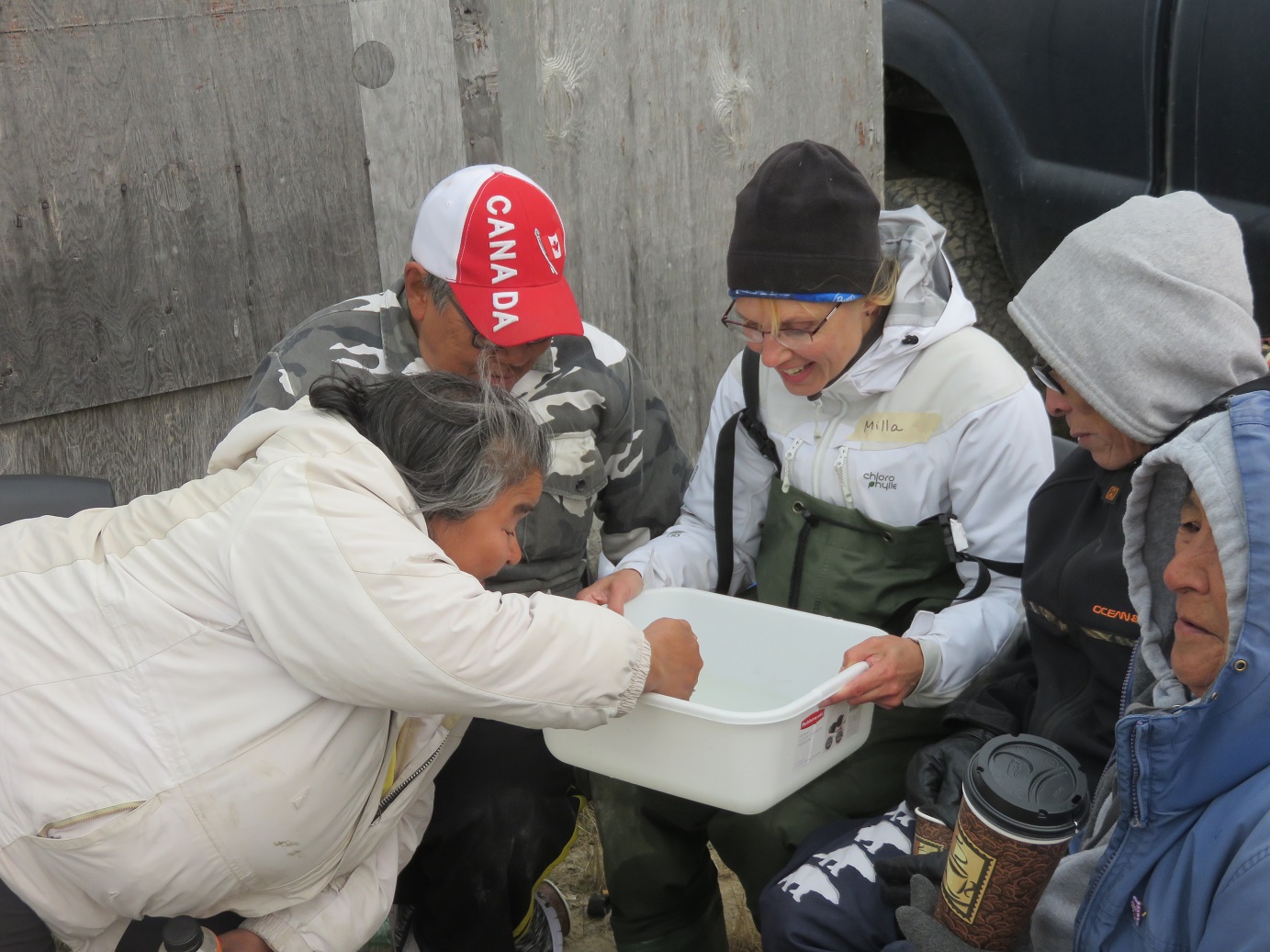Omega-3 fatty acids and mercury in the food web of Greiner Lake
Authors
- M. Rautio, Département des Sciences Fondamentales, Université du Québec à Chicoutimi, Chicoutimi, Québec, Canada, milla.rautio@uqac.ca
- M. Evans, Environment and Climate Change Canada, Saskatoon, Saskatchewan, Canada
- G. Grosbois, Environment and Climate Change Canada, Saskatoon, Saskatchewan, Canada
- M. Power, Department of Biology, University of Waterloo, Waterloo, Ontario, Canada
Citation information
Rautio, M., Evans, M., Grosbois, G. and Power, M. 2020. Omega-3 fatty acids and mercury in the food web of Greiner Lake. Polar Knowledge: Aqhaliat Report, volume 3, Polar Knowledge Canada, p. 30–33. DOI: 10.35298/pkc.2020.08.eng
Article
Arctic char and lake trout contribute substantially to traditional Inuit meals by providing essential sources of Omega-3 (ω3) fatty acids, protein, and other nutrients necessary for good health. However, the fish can also be a source of mercury (Hg) and persistent organic contaminants. We investigated arctic char, whitefish, lake trout and least cisco from Greiner Lake, which supports a major domestic fishery for the community of Cambridge Bay. Two types of arctic char are believed to live and feed in Greiner Lake. Sea-run char migrate every second year to the sea to feed intensively on abundant marine life during a period of several weeks in the summer and form the basis of the commercial fishery. These chars are believed not to feed after their return from the sea. Resident char, on the other hand, do not migrate to the sea but feed in the lake. Whitefish, lake trout and least cisco apparently do not migrate to the sea but reside permanently in the lake. Essential Omega-3 fatty acids, which are manufactured by phytoplankton, move up through the food web via zooplankton and benthic invertebrates to fish, and ultimately to humans. Hg is bioaccumulated by all biota and biomagnified in food webs, with apex predators having the highest Hg concentrations. Consumption advice for fish is based, in part, on their Hg concentrations. Thus, there is a balance between the benefits and risks of consuming top fish predators.
Working in close collaboration with the Ekaluktutiak Hunters Trappers Organization and through active engagement of local northerners (Figure 1), we sampled 26 resident arctic char, 29 whitefish, 17 lake trout, and 28 least ciscoes, in August 2017 and 2018. The fish ranged from 17.8 to 62.2 cm in length. The average age of the sampled arctic char was 9.2 ± 2.6 years, while the average ages of the whitefish and lake trout were 14.4 ± 6.4 years old and 25.6 ± 9.5 years old, respectively. Age was not determined for least cisco. Fillet samples were analyzed for Hg at the Environment and Climate Change Canada (ECCC) lab in Saskatoon and for fatty acids in the limnology lab at Université du Québec à Chicoutimi (UQÀC).
Arctic char fed on sticklebacks, amphipods and other organisms close to the shore and bottom, but also on zooplankton in the open water. They had the highest concentration of Omega-3 fatty acids (11.4 ± 1.5 mg/g DW), followed by whitefish (10.1 ± 0.3 mg/g DW) that fed on open water zooplankton (Figure 2a). Lake trout had similar feeding habits as the char and a low amount of Omega-3 fatty acids (6.2 ± 0.4 mg/g DW). Least cisco had even less (4.1 ± 0.1 mg/g DW) of these health-determining compounds. Open water zooplankton are known for their ability to store high quality lipids and were the most Omega-3-rich organisms in this lake (172.0 ± 11.1 mg/g DW) (Figure 2b).
Hg concentrations in the fish increased with their size and trophic feeding level (Figure 3). Hg concentrations were highest in lake trout (max. 0.89 µg/g), possibly because of the extreme age and slow growth rates of these predators. Lake whitefish had surprisingly high Hg concentrations (max. 0.55 µg/g), which may in part be related to where they are feeding in the lake. Resident arctic char had lower Hg concentrations (max. 0.21 µg/g), which is more typical of what is expected for lake whitefish and observed for other resident and landlocked populations. The community has been informed of our fish Hg and Omega-3 fatty acid results through plain language posters and presentations. Fish Hg findings have also been made available to Nunavut Health. With their very low Hg concentrations and high Omega-3 fatty acids, arctic char provides the best nutritional balance between risk and benefits when it comes to fish consumption.

Figure 1a: Milla Rautio shows aquatic organisms to Ekaluktutiak elders during an Open House at Greiner Lake. Photo credit: G. Grosbois

Figure 1b: Alysha Wilson-Maksagak first helped us in catching fish and then took the flesh that was not used for scientific analyses and prepared it for the elders. Photo credit: M. Rautio

Figure 2: Omega-3 fatty acid concentrations in Greiner Lake a) fish, and b) open water and shore/bottom organisms in 2017 and 2018. The values are mean ± SE.

Figure 3: Mercury concentrations in Greiner Lake fish in 2017 and 2018. The dotted line indicates the 0.5 µg/g commercial sale guideline.
References
- Evans, M.S., Muir, D.C., Keating, J., and Wang X., 2015. Anadromous char as an alternate food choice to marine animals: a synthesis of Hg concentrations, population features and other influencing factors. The Science of the Total Environment. doi: 10.1016/j.scitotenv.2014.10.074.
- Ruess, L., and Müller-Navarra, D.C., 2019. Essential Biomolecules in Food Webs. Frontiers in Ecology and Evolution, 7(269). doi:10.3389/fevo.2019.00269.
Polar Knowledge Canada
For media inquiries, contact:
communications@polar-polaire.gc.ca
Page details
- Date modified: